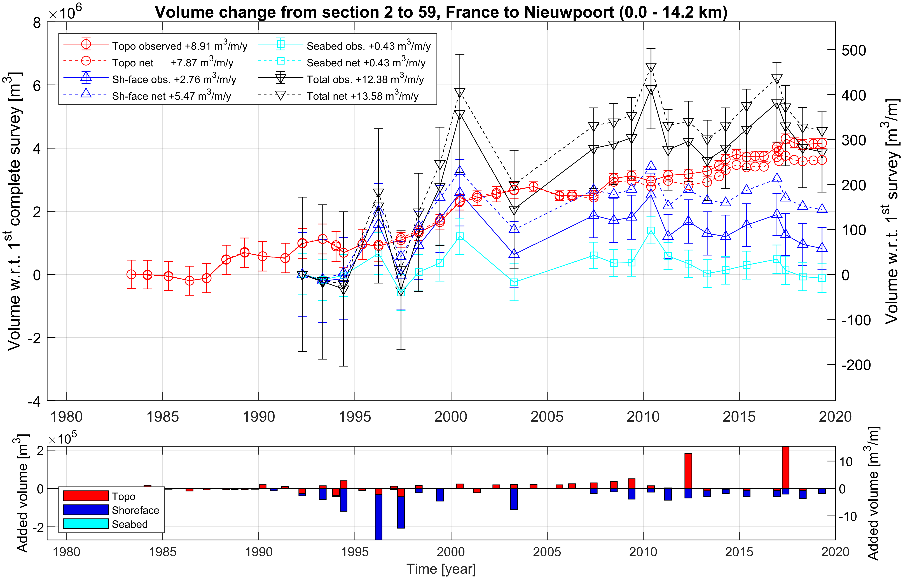B. Roest1*, P. Rauwoens1
1 KU Leuven
*corresponding author:
Introduction
The western part of the Belgian coast between the French border and Nieuwpoort/River Yser (14 km) is characterised by a wide dune area, which is interrupted by sea dikes in coastal towns (6 km). The beach is wide with multiple intertidal bars. Only a few groynes are present near Koksijde and Nieuwpoort-Bad. Regarding coastal management and safety, a sediment budget is determined for this part of the Belgian coast. This zone requires limited maintenance. Anthropogenic influences include beach reshaping for recreational purposes, beach nourishment and dredging. An important morphological feature is the Trapegeer-Broersbank, a large sand bank that is obliquely connected to the shoreface at Koksijde (Verwaest et al. 2020).
The Belgian coast is among the best monitored worldwide. Timeseries of volumes are available for the past four decades, furthermore data of nourishment and dredging volumes are available (Houthuys & Roest, 2019). Therefore it is possible to discern between observed volume changes and autonomous behaviour, provided that nourishments and dredging operations do not significantly alter coastal behaviour.
Methods
Time series per coastal section are aggregated alongshore to present the large-scale volumetric development. Volumes are determined for supra- and intertidal area (topo), shoreface and sea-bed (below the depth of closure). Nourishment and dredging volumes are cumulatively subtracted from the observed timeseries to obtain autonomous behaviour (Houthuys & Roest, 2019).
Results
The dune area steadily gains sediment. Two larger nourishments for coastal protection were installed since 2012, increasing the positive sediment budget of dunes and beach (Figure 1). Dredging of the Nieuwpoort access channel takes place continuously and sediments are dumped outside this zone, which is the main cause of the decreasing shoreface sediment budget. Volumetric changes are not uniform alongshore. Shoreward migration of the Trapegeer-Broersbank and tidal channel Potje do not influence the large-scale sediment budget, but lead to local erosion and deposition.

Figure 1: Volumetric changes of the Belgian West Coast. Beach and Dune volumes (red) steadily increase, while Shoreface volumes (blue) show a slow decrease in the last decades. Observed (full lines) and 'autonomous' volumes (dashed lines).
References
Houthuys, R. & Roest, L.W.M. (2019). Belgian coastal volumes per coastal stretch (1979-2019). Dataset. VLIZ.
Verwaest, T., Houthuys, R., Roest, B., Dan, S. & Montreuil, A-L. (2020). A Coastline Perturbation caused by Natural Feeding from a Shoreface-connected Ridge (Headland Sint-André, Belgium). Journal of Coastal Research, 95 (SI): 701–705. https://doi.org/10.2112/SI95-136.1
I. Surname1*, F.N. Another-Surname2 , Y. Next-Surname2
1 University Name, Country; 2 Organization Name, Country
* Corresponding author: mail.name@organization.org


